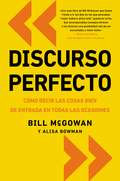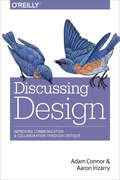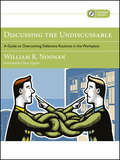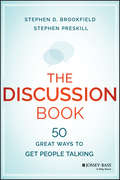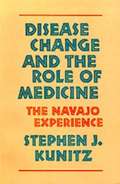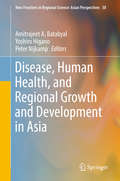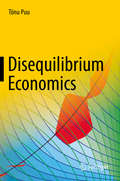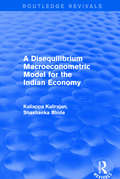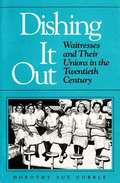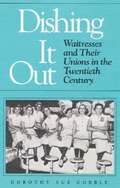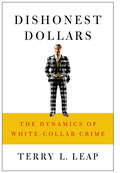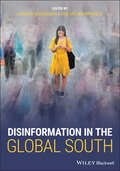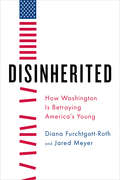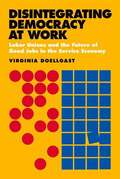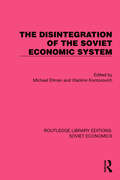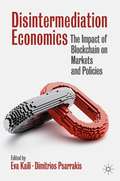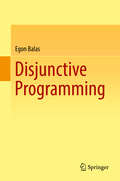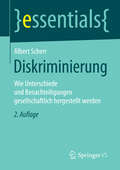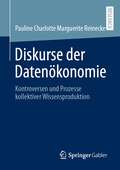- Table View
- List View
Discurso perfecto: Cómo decir las cosas bien de entrada en
by Bill McgowanDecir lo correcto de la manera correcta puede hacer la diferencia entre sellar el acuerdo o la pérdida de la cuenta, obtener un ascenso, o conseguir una carta de despido. Es esencial tener un discurso perfecto- para obtener el mensaje correcto a la persona adecuada en el momento adecuado. En Discurso Perfecto, Bill McGowan muestra cómo elaborar el mensaje correcto y entregarlo utilizando el lenguaje verbal y no verbal adecuado. Discurso Perfecto te enseña cómo superar dificultades de comunicación comunes utilizando simples principios de McGowan de persuasión, que son muy eficaces y fáciles de aprender, implementar y dominar. Con Discurso Perfecto se puede aprovechar el poder de la persuasión y que la gente no sólo escuche atentamente a cada palabra, pero también la recuerde mucho tiempo después que has dejado la habitación.
Discussing Design: Improving Communication and Collaboration through Critique
by Adam Connor Aaron IrizarryReal critique has become a lost skill among collaborative teams today. Critique is intended to help teams strengthen their designs, products, and services, rather than be used to assert authority or push agendas under the guise of "feedback." In this practical guide, authors Adam Connor and Aaron Irizarry teach you techniques, tools, and a framework for helping members of your design team give and receive critique.Using firsthand stories and lessons from prominent figures in the design community, this book examines the good, the bad, and the ugly of feedback. Youâ??ll come away with tips, actionable insights, activities, and a cheat sheet for practicing critique as a part of your collaborative process.This book covers:Best practices (and anti-patterns) for giving and receiving critiqueCultural aspects that influence your ability to critique constructivelyWhen, how much, and how often to use critique in the creative processFacilitation techniques for making critiques timely and more effectiveStrategies for dealing with difficult people and challenging situations
Discussing the Undiscussable: A Guide to Overcoming Defensive Routines in the Workplace
by William R. NoonanSince his 1990 landmark book Overcoming Organizational Defenses, Chris Argyris has extensively researched and written about how well-meaning, smart people create vicious cycles of defensive behavior to protect themselves from embarrassment and threat. In Discussing the Undiscussable, Bill Noonan enlivens the scholarly work of Chris Argyris through the use of reflective exercises and easy-to-read chapters that illuminate the basic human experience endemic to the creation of defensive routines. This book offers hope for altering organizational defensive routines by leveraging the greatest opportunity for change--the way we think and act.Discussing the Undiscussable provides a set of practical "how to do" exercises for detecting, surfacing, and discussing organizational defensive routines in a safe and productive way. The combination of text, business fable, and interactive and reflective exercises is versatile in its application to both individuals and groups. The companion DVD contains video vignettes of the book's business fable where the actors model both defensive routines and virtuous cycles of behavior. Readers will instantly recognize what has long been going on in the workplace, and will be able to develop the skills to talk about it productively.
Discussion: Where Minds Meet
by Richard LueckeThis chapter emphasizes that coaching actively requires not only direct observation, but a thorough discussion of what was objectively observed during the preparation phase. This important step provides both parties, coach and subordinate, the opportunity to talk openly about both perspectives in an attempt to identify where help is needed. Together, they can decide how to proceed and where to make improvements.
The Discussion Book
by Stephen Preskill Stephen D. BrookfieldBuild teams, make better decisions, energize groups, and think out of the box Do you need a resource that you can pull out of your pocket to liven up meetings, trainings, professional development, and teaching? The fifty easily applied techniques in this timely manual spur creativity, stimulate energy, keep groups focused, and increase participation. Whether you're teaching classes, facilitating employee training, leading organizational or community meetings, furthering staff and professional development, guiding town halls, or working with congregations, The Discussion Book is your go-to guide for improving any group process. Each of the concrete techniques and exercises is clearly described with guidance on selection and implementation, as well as advice on which pitfalls to avoid. All of the techniques: Offer new ways to engage people and energize groups Get employees, students, colleagues, constituents, and community members to participate more fully in deliberative decision-making Encourage creativity and openness to new perspectives Increase collaboration and build cohesive teams Keep groups focused on important topics and hard-to-address issues Derived from the authors' decades of experience using these exercises with schools, colleges, corporations, the military, social movements, health care organizations, prisons, unions, non-profits, and elsewhere, The Discussion Book will help you guide discussions that matter.
Disease Change and the Role of Medicine: The Navajo Experience
by Stephen J. Kunitz Charles M. LeslieStephen Kunitz's work raises crucial issues for public policy in the medical field, and will be valuable for social scientists, physicians, and health professionals concerned with the social context of public health and other medical facilities.
Disease, Human Health, and Regional Growth and Development in Asia (New Frontiers in Regional Science: Asian Perspectives #38)
by Amitrajeet A. Batabyal Yoshiro Higano Peter NijkampThis book brings together new studies on regional disparities in the provision and maintenance of health in Asia. Specifically, the individual chapters shed light on the various health challenges that Asian regions face with regard to environmental health, communicable and non-communicable diseases, reproductive health, and the development of health systems. The book departs from the existing literature on this subject in three ways. First, it explicitly recognizes that health is essential to the daily lives of human beings. Second, it underscores the fact that good health improves learning, employee productivity, and incomes. Third, the book demonstrates the ways in which an understanding of the preceding two points contributes to our grasp of economic growth and development. Because Asia is now the fastest-growing and most dynamic continent in the world, the respective chapters provide practical guidance concerning two key questions: First, how do we effectively address the health challenges in individual regions of Asia? Second, how do we ensure that the proposed health interventions lead to sustainable economic growth and development? To this end, the book emphasizes modeling and illustrates the role that sound empirical modeling can play in developing measures that sustainably address the health challenges confronting disparate Asian regions. All chapters were written by international experts who are active researchers in their respective fields. Hence, this book is highly recommended to all readers seeking an in-depth and up-to-date perspective on some of the most important issues at the interface of human health and regional growth and development in Asia.
Diseñada para reinar: Cómo equipar a la mujer para que logre su destino divino
by Kris VallottonEs hora de una revolución La mujer fue extraída del hombre en el jardín del Edén para que permaneciera a su lado y reinara con él. Satanás, sin embargo, se las ha ingeniado para despojar a las mujeres y los hombres de sus legítimas identidades, menoscabándolos y privándolos de su poder original. El mundo implora para que esta asociación original divina sea restablecida a su equilibrio primigenio, lo cual es posible. Únase a Kris Vallotton en un viaje extraordinario que abrirá su entendimiento, y que incluye: - El verdadero plan y propósito de Dios para las mujeres - Las enseñanzas radicales de Jesús y su especial preocupación por las mujeres - El importante papel de los hombres en la restauración de las mujeres - La verdadera interpretación de pasajes bíblicos difíciles relacionados con las mujeres - Ejemplos de mujeres en el liderazgo, según el propósito de Dios Dios diseñó a las mujeres para que reinaran juntamente con los hombres. Jesús nos libertó para que asumiéramos nuestras verdaderas identidades. Es hora de que todos, como hijos e hijas del Rey, gobernemos juntos. ¡PREPARESE Y SEA PARTICIPE DE ESTA REVOLUCION!
Disequilibrium Economics
by Tönu PuuThis book discusses mathematical models for various applications in economics, with a focus on non-linear dynamics. Based on the author’s over 50 years of active work in the field, the book has been inspired by models from the period between 1920 and 1950. Following a brief introduction to economics for mathematicians and other modelers, it assembles a repository of useful specific functions for global dynamic modeling. Furthermore, twelve “research stubs” – outlined research agendas that have not yet been fully worked on – are suggested for further study and could even be expanded to entire research projects. The book is a valuable resource, particularly for young scientists who are skilled in mathematical and computational techniques and are looking for applications in economics.
A Disequilibrium Macroeconometric Model for the Indian Economy
by Kaliappa Kalirajan Shashanka BhideThis title was first published in 2003. This text presents a new approach to incorporating regional details on production in a disequilibrium macroeconometric model. The early studies on disequilibrium dealt with either partial-adjustment models or models involving excess demand or supplies in markets. In this study the authors consider a different type of disequilibrium model - one in which econometric analysis makes use of the varying coefficients stochastic production frontier approach, which permits estimation and analysis of production efficiencies of individual producers. The book also presents an innovative approach to production modelling in macro econometric models as it provides a useful framework for incorporating production efficiencies and regional details of production in the macro models. It is a pioneering study that combines the stochastic frontier approach with macro econometric modelling. Primarily focused on India, it also provides insights into problems in modelling economies of other developing countries.
Disequilibrium Trade Theories (Fundamentals Of Pure And Applied Economics Ser. #Vol. 23)
by M. Itoh T. NegishiTwo of Japan's leading economists - Motoshige Itoh and Takashi Negishi - look at trade models in a disequilibrium context.
Dishing It Out: Waitresses and Their Unions in the Twentieth Century (Women, Gender, and Sexuality in American History)
by Dorothy CobbleThis book will expand our understanding of feminism and unionism by including the gender conscious perspectives of working women.
Dishing It Out: Waitresses and Their Unions in the Twentieth Century
by Dorothy Sue CobbleAn invaluable history book about a large segment of the twentieth century workforce--waitresses.
Dishonest Dollars: The Dynamics of White-Collar Crime
by Terry L. LeapIn an environment where corporate scandals fill the headlines and ethics courses have suddenly become standard fare in business schools, Terry Leap offers welcome insights into and useful ways of thinking about a critical problem that permeates our society. His main contribution is an integrative model of white-collar crime, which smoothly incorporates influences from sociology, psychology, public policy, and business. As he explains the process that occurs across the many different categories of crimes within organizations, he finds that there are more similarities than differences between "criminals in the suites" and "criminals in the streets."Leap's definition of crimes within organizations and the people who commit them are laid out in his first chapter. He then goes on to discuss the causes of and events surrounding white-collar crime, types of crimes and criminals, the decision-making processes of white-collar criminals, and the impact of these crimes. His concluding chapter predicts future trends in corporate crime, including an explanation of why we are likely to see more crime in health care. Throughout, Leap presents numerous specific examples and cases—from famous meltdowns such as Enron and WorldCom to less-publicized incidents including a weight-loss franchisee mislabeling doughnuts as low fat and a CEO of a South Carolina regional transportation authority misusing taxpayer money for lavish meals, personal expenses, and world travel.
Disinflation in Transition, 1993-97
by Carlo Cottarelli Peter DoyleThe latest in a series of papers published by the International Monetary Fund on economies in transition examines the experience of disinflation in Central and Eastern Europe, the Baltics, Russia, and other countries of the former Soviet Union between 1993 and 1997. the paper reviews the economic policies underlying the dramatic drop in inflation during those years as well as other variables that facilitated the disinflation and notes that the adjustment of fiscal fundamentals as the driving force behind the disinflation, while nominal anchoring arrangements played a less prominent role. This was contrary to developments in countries, for example, in Latin America, that had experienced high inflation for a long period of time.
Disinformation in the Global South
by Herman Wasserman Dani Madrid-MoralesA timely and incisive exploration of disinformation and its impact in the Global South In Disinformation in the Global South, media and communications scholars Herman Wasserman and Dani Madrid-Morales deliver a unique and geographically diverse collection of perspectives on the phenomenon of disinformation as it manifests in the Global South. In many parts of the Global South, coordinated political disinformation campaigns, rumor, and propaganda have long been a part of the social fabric, even before disinformation has become an area of scholarship in the Global North. The way disinformation manifests in this region, and responses to it, can therefore be highly instructive for readers around the world. Through case studies and comparative analyses, the book explores the impact of disinformation in Africa, Latin America, the Arab World and Asia. The chapters in this book discuss the similarities and differences of disinformation in different regions and provide a broad thematic overview of the phenomenon as it manifests across the Global South. After analyzing core concepts, theories and histories from Southern perspectives, contributors explore the experiences of media users and the responses to disinformation by various social actors drawing on examples from a dozen countries. Disinformation in the Global South also includes: A thorough introduction to Southern perspectives on national histories, theories of disinformation, and research methods in disinformation studies Global case studies of cultures of disinformation, including ethnographic insights into how audiences engage with disinformation Comprehensive explorations of responses to online and offline disinformation, including discussions of news literacy and the management of disinformation A valuable resource for scholars of disinformation everywhere, as well as senior undergraduate and graduate students in courses covering transnational or global perspectives to communication studies, Disinformation in the Global South is also an ideal reference for anyone studying or working in media or journalism.
Disinherited
by Diana Furchtgott-Roth Jared MeyerTens of millions of Americans are between the ages of 18 and 30. These Americans, known as millennials, are, or soon will be, entering the workforce. For them, achieving success will be more difficult than it was for young people in the past.This is not because they are less intelligent, they have worked less hard, or they are any less deserving of the American dream. It is because Washington made decisions that render their lives more difficult than those of their parents or grandparents. Their younger siblings and their children will be even worse off, allbecause Washington has refused to fix the problem.This book describes the personal stories of several members of this disinherited generation. Their experiences are not unique. It is impossible to hear these stories and not understand that holding back a nation's young is the antithesis of fairness and no way to make economic or social progress.Their stories are an indictment of America's treatment of its young. A nation that prides itself on its future has mortgaged it. A nation that historically took pride in its youth culture has become a nation that steals from its young. People who should have fulfilling, productive lives are sidelined, unemployed, or underemployed.Meanwhile, America expects millennials and others of the disinherited generation to pay higher taxes for government programs that benefit middle-aged and older Americans, many of whom have better jobs and more assets.It is time someone told the full story of the crisis facing America's young. The future of America can be saved, but only if our government's betrayal comes to an end. It is a war without victors, only victims. The birthright of the America's young must be restored, and the time to do so is now. This book explains how.
Disintegrating Democracy At Work
by Virginia DoellgastThe shift from manufacturing- to service-based economies has often been accompanied by the expansion of low-wage and insecure employment. Many consider the effects of this shift inevitable. In Disintegrating Democracy at Work, Virginia Doellgast contends that high pay and good working conditions are possible even for marginal service jobs. This outcome, however, depends on strong unions and encompassing collective bargaining institutions, which are necessary to give workers a voice in the decisions that affect the design of their jobs and the distribution of productivity gains. Doellgast's conclusions are based on a comparative study of the changes that occurred in the organization of call center jobs in the United States and Germany following the liberalization of telecommunications markets. Based on survey data and interviews with workers, managers, and union representatives, she found that German managers more often took the "high road" than those in the United States, investing in skills and giving employees more control over their work. Doellgast traces the difference to stronger institutional supports for workplace democracy in Germany. However, these democratic structures were increasingly precarious, as managers in both countries used outsourcing strategies to move jobs to workplaces with lower pay and weaker or no union representation. Doellgast's comparative findings show the importance of policy choices in closing off these escape routes, promoting broad access to good jobs in expanding service industries.
The Disintegration of the Soviet Economic System (Routledge Library Editions: Soviet Economics #3)
by Michael Ellman Vladimir KontorovichThe Disintegration of the Soviet Economic System (1992) examines in detail the collapse of the Soviet economic system, and is set in its political context, both international and domestic. The collapse is looked at from a macroeconomic point of view, both real and financial, as well as from a mesoeconomic viewpoint, with chapters on such important sectors such as agriculture and the railways. Because the USSR is such a large country it is also looked at in a regional perspective, with chapters on Central Asia and the allocation of investment between republics, and attention is also paid to the welfare of the population, their health and the development of their consumption, and the environment and technical progress.
Disintermediating the Banks: ThinCats and the Peer-to-Peer Lending Industry
by Lauren H. Cohen Tom Grant Christopher Malloy William PowleyDisintermediating the Banks: ThinCats and the Peer-to-Peer Lending Industry by Lauren Cohen, Tom Grant, Christopher Malloy and William Powley
Disintermediation Economics: The Impact of Blockchain on Markets and Policies
by Eva Kaili Dimitrios PsarrakisThis book provides a coherent Blockchain framework for the business community, governments, and universities structured around microeconomics, macroeconomics, finance, and political economy and identifies how business organizations, financial markets and governmental policies are changed by digitalization, specifically Blockchain. This framework, what they authors call “disintermediation economics,” affects everything by providing a paradigm that transforms the way we organize markets and value chains, financial services, central banking, budgetary policies, innovation ecosystems, government services, and civil society. Bringing together leading and experienced policy makers, corporate practitioners, and academics from top universities, this book offers a road map of best practices that can be immediately useful to firms, policy makers as well as academics by balancing theory with practice.
Disintermediation in Two-Sided Marketplaces
by Benjamin Edelman Philip HuTwo-sided marketplaces often risk disintermediation: Users may rely on the marketplace to find each other, but then perform related future transactions--or even the current transaction--without the platform's involvement and without paying any fees the platform may charge. This technical note assesses which marketplaces are most vulnerable to disintermediation, and offers a set of strategies marketplaces can implement in order to reduce their vulnerability.
Disjunctive Programming
by Egon BalasDisjunctive Programming is a technique and a discipline initiated by the author in the early 1970's, which has become a central tool for solving nonconvex optimization problems like pure or mixed integer programs, through convexification (cutting plane) procedures combined with enumeration. It has played a major role in the revolution in the state of the art of Integer Programming that took place roughly during the period 1990-2010. The main benefit that the reader may acquire from reading this book is a deeper understanding of the theoretical underpinnings and of the applications potential of disjunctive programming, which range from more efficient problem formulation to enhanced modeling capability and improved solution methods for integer and combinatorial optimization. Egon Balas is University Professor and Lord Professor of Operations Research at Carnegie Mellon University's Tepper School of Business.
Diskriminierung: Wie Unterschiede und Benachteiligungen gesellschaftlich hergestellt werden (essentials)
by Albert ScherrAlbert Scherr fasst zentrale Einsichten der sozialwissenschaftlichen Diskriminierungsforschung in einer leicht verständlichen Weise zusammen. Denn unterschiedliche Formen von Diskriminierung gehören zur sozialen Realität - so auf dem Arbeitsmarkt, in der schulischen und beruflichen Bildung, bei der Vergabe von Wohnungen oder auch durch herabwürdigende Äußerungen im Alltag.
Diskurse der Datenökonomie: Kontroversen und Prozesse kollektiver Wissensproduktion
by Pauline Charlotte ReineckeDie Potentiale und Risiken der Datenökonomie sind Gegenstand anhaltender Kontroversen. Zur Untersuchung dieser Kontroversen wird eine wissenssoziologische Diskursanalyse von Diskursdaten im Zeitraum von 2010 bis 2020 durchgeführt. Die Ergebnisse zeigen eine Demokratisierung der Technologieentwicklung durch die Austragung von Kontroversen im öffentlichen Diskurs sowie in politisch eingerichteten „hybriden Foren“. Die Arbeit erweitert die Forschung über die Kontroversen und kollektiven Wissensprozesse in der Datenökonomie.
